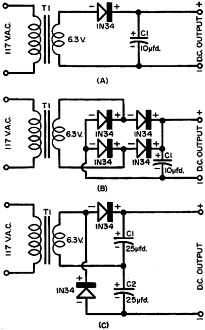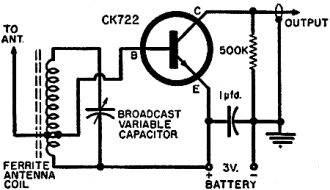Transistor Topics
|
|
Popular Electronics magazine ran their "Transistor Topics" column for many years, and this is the third in the series. Unfortunately, I do not yet have the previous two editions, but someday... Transistors were a relatively new phenomenon at the beginning of 1956, so there was a lot to learn and a lot of people to teach about them. It might have been easier to make converts of dedicated tube users if the JFET (junction field effect transistor) had been commercialized before the BJT (bipolar junction transistor), since the JFET (voltage on the gate controls current flow) acts more like the familiar vacuum tube (voltage on the control grid controls current flow) than the BJT (current on the base controls current flow). See other "Transistor Topics" in the series: January 1956, December 1957, March 1958, February 1960, April 1960 Transistor Topics
Diode Rectifier Supplies Power supplies for transistor experiments. The circuit in (A) is a simple hall-wave rectifier, in (B) a bridge rectifier. and in (C) a simple voltage doubler. All of these circuits employ the common 1N34 crystal diode. The material below originated with Mr. Rufus Turner, Contributing Editor of POP-'tronics. We have quoted directly from his letter to us. "Transistors have become so closely associated with battery operation that the mere mention of a power line-operated d.c. supply for a transistor circuit brings forth looks of amused astonishment. "To be sure, transistors do permit long-life operation of some circuits which, when 'tubed,' cannot be powered by batteries without running into expense. But there also are some places where it seems pointless not to run the transistor from the power line. I saw an example in print recently. The subject was a clever transistorized photo timer. Battery operated, of course, but why? The timer relay switched the a.c. line on and off to an enlarger or print box. Since the power line had to pass through the timer anyway, there seemed little point in ignoring it for transistor bias. Another familiar example is the transistorized burglar alarm that sets off a line-operated signal but is operated from self-contained batteries. You can name others. "The striking features of the transistor are not lost, as many workers seem to fear, when the a.c. line is used - where sensible - for transistor power. No matter from what source it receives its d.c. bias, the transistor still is tiny, power-thrifty, non-microphonic, cool-running, practically indestructible, and long-lived. "Because transistor current and voltage requirements are low, an a.c. power supply can be small in size. This is compatible with transistor dimensions. A midget 6.3-volt filament transformer is entirely adequate. Germanium diodes may be employed as the rectifiers, and miniature electrolytic capacitors used for storage. Where voltages higher than 6.3 are needed, voltage multiplier circuits may be employed. "The schematics show practical transistor power supply circuits employing germanium diodes. In each case, T1 is a 1-ampere, 6.3-volt filament transformer. The circuits have been tested at a constant a.c. input voltage of 115 volts and their d.c. output characteristics are given in the graph. Except in the case of the doubler, the curves have not been carried beyond the current level at which the d.c. output voltage falls to 6.3, the r.m.s. voltage of the transformer secondary. "These circuits will be satisfactory, as given, for most low-drain circuits employing one or two transistors at fixed operating voltages. For better voltage regulation (less fall-off of voltage as the current increases) and higher output currents (such as will be required for multi-stage transistor circuits containing bias resistor networks), Type 1N91 miniature germanium rectifiers may be substituted for the 1N34 diodes, and the capacitor values increased. A 1N91 in the simple half-wave circuit with C1 = 100 μfd. gives 60-ma. output at 6.3 volts d.c., contrasted to the 5 ma. at 6.3 volts obtained with the 1N34 and 10 μfd. Output of the bridge, doubler, tripler, and quadrupler circuits likewise will be improved. This is a simple voltage tripler using readily available 1N34 crystal diodes. Adding another capacitor and crystal diode to the circuit above enables it to operate as a voltage quadrupler. Circuit of the transistorized "radio add-on" unit suggested by Ed Noll. It is similar to that outlined by Homer Davidson in our September 1955 issue. "The curves in the graph were plotted from data taken in measurements on the circuits exactly as they are shown here and without additional filters. In some transistor applications, especially sensitive amplifiers, filters will be required. These may be of the simple, small-sized, resistance-capacitance type. However, a sharper voltage fall-off must be expected as a result of voltage drop across the filter resistor." Many thanks to you, Rufus, for the interesting ideas presented above. We hope that our readers will take advantage of your schematics and suggestions. By the way, we have scheduled for early appearance in this column a complete power supply unit for transistor experiments. It is a variable voltage supply with an output of from 2 to 30 volts. Speaking of power supplies, we might also report that another Contributing Editor is working on several silicon solar battery hook-ups. Although the price of the "real" silicon battery is still high, we feel that something concerning its use and application should appear in this column. Another "Radio Add-On" An additional suggested circuit this month comes from Ed Noll, whose many articles and books on TV servicing and operation are known from coast to coast. Ed brings to our attention the circuit shown below. It is used much like the original "Radio Add-On" described in the September 1955 issue (page 48). In other words, the output is plugged into the phono jack on a TV receiver. After the base-emitter detector is tuned up, it will bring in a single AM broadcast station. Switching the TV receiver to the phono setting will enable the viewer to hear this station. The advantage is two-fold: better fidelity from the AM station and greater use of the TV receiver during "off-hours." The circuit is uncomplicated since many ferrite antenna coils are now sold with the tap shown in the diagram. This tap is generally used for an external antenna. In this circuit it provides an additional impedance match between the resonant circuit and the low impedance input to the transistor base-emitter circuit. Don't forget that also in this circuit there is internal coupling in the transistor. The collector circuit provides audio amplification of the rectified and detected signal. Next month we go back to some receiver plans based on ideas suggested by you readers. Keep your letters coming.
Posted February 26, 2024 |
|

 In opening the third installment of this department,
we want to express our appreciation for the many letters and cards asking that it
be continued and that it be published monthly. Many thanks to all who took the time
and trouble to write.
In opening the third installment of this department,
we want to express our appreciation for the many letters and cards asking that it
be continued and that it be published monthly. Many thanks to all who took the time
and trouble to write. 


